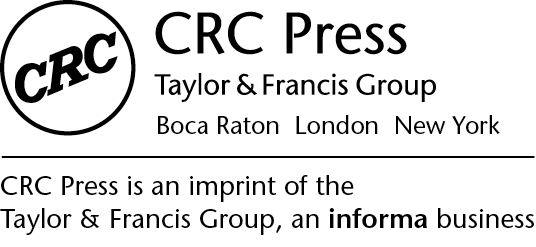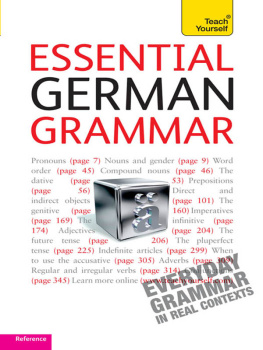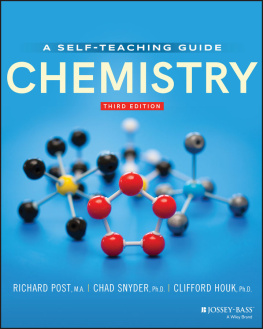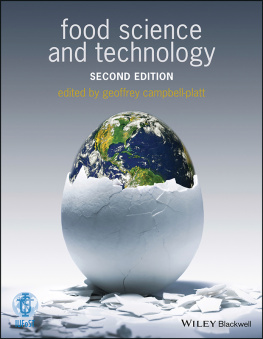Introducing Food Science, Second Edition
Robert L. Shewfelt
Alicia Orta-Ramirez
Andrew D. Clarke

CRC Press
Taylor & Francis Group
6000 Broken Sound Parkway NW, Suite 300
Boca Raton, FL 33487-2742
2015 by Taylor & Francis Group
CRC Press is an imprint of Taylor & Francis Group, an Informa business
No claim to original U.S. Government works
Version Date: 20151026
International Standard Book Number-13: 978-1-4987-6664-7 (EPUB)
This book contains information obtained from authentic and highly regarded sources. Reasonable efforts have been made to publish reliable data and information, but the author and publisher cannot assume responsibility for the validity of all materials or the consequences of their use. The authors and publishers have attempted to trace the copyright holders of all material reproduced in this publication and apologize to copyright holders if permission to publish in this form has not been obtained. If any copyright material has not been acknowledged please write and let us know so we may rectify in any future reprint.
Except as permitted under U.S. Copyright Law, no part of this book may be reprinted, reproduced, transmitted, or utilized in any form by any electronic, mechanical, or other means, now known or hereafter invented, including photocopying, microfilming, and recording, or in any information storage or retrieval system, without written permission from the publishers.
For permission to photocopy or use material electronically from this work, please access www.copyright.com or contact the Copyright Clearance Center, Inc. (CCC), 222 Rosewood Drive, Danvers, MA 01923, 978-750-8400. CCC is a not-for-profit organization that provides licenses and registration for a variety of users. For organizations that have been granted a photocopy license by the CCC, a separate system of payment has been arranged.
Trademark Notice: Product or corporate names may be trademarks or registered trademarks, and are used only for identification and explanation without intent to infringe.
Visit the Taylor & Francis Web site at http://www.taylorandfrancis.com
and the CRC Press Web site at www.crcpress.com
CRC Press is a premier publisher of scientific, technology and medical content, reaching around the globe to publish the pioneering achievements of science that provide researchers, professionals, and students with the resources they need to make further advances. CRC Press is a member of Taylor & Francis Group, an informa business.
For more authoritative books in your field and for in-depth information about CRC Press books, visit www.crcpress.com
- Join our email list to receive exclusive, unadvertised discounts and alerts when new books publish in your field
- Visit Featured Authors to learn about your favorite author with detailed bios, news about their work, and discussions of their research
- Read the latest book reviews from industry experts, influencers, and thought leaders about STM (Science, Technology and Medicine) reference and textbooks
The tables in this ebook have been modified to enhance the reader experience. On compatible devices, the enhancement should keep the header rows visible as you scroll through a table.
Please report any issues with this ebook or any desired enhancements to the .
www.crcpress.com
The second edition of this book is dedicated to
Betty and Sweetie who wait patiently each day while I write before I can take advantage of being retiredRob.
My students: past, present, and futureAlicia.
My wife Kristi and our children Alex, Maddie, and LiamAndrew.
Preface
This second edition has added two authors and three new contributors to specific chapters. We have also added a chapter on Sustainability and Distribution to acknowledge growing interest among the food science community in this topic. Much has happened in food science since the first edition was published. Processed foods have come under a more concerted attack from many sources, although most of these sources do not define what constitutes a processed food as opposed to a whole food. Consumers are confused by such a discussion and appear to make a distinction between processed and packaged foods that may not be merited. In this edition, we address such issues and provide our perspective as food scientists on processed, formulated, chilled, and prepared foods. We have updated the text of the first edition and almost half of the illustrations are new. A glossary has been added to this book and key terms are presented in bold when they first appear in the book.
Both editions were specifically designed to provide an overview of the field of food science for the major and non-major alike. The narrative proceeds from a nontechnical discussion of food issues that concern todays student to a more comprehensive technical overview of the basic principles as they relate to the study of food. Sandwiched in between are descriptions of the types of commercial products and processes with particular reference to nutritional consequences and primary functions of roles of food scientists. Each section builds on the previous section, providing a logical structure and cohesiveness. At the end of each chapter, we have included in the second edition a series of problems to help students test their ability to comprehend the material and to provide instructors a reservoir for assignments, class discussions, and test questions. All of these problems are stated in a format that can be linked to Blooms taxonomy as it relates to IFT Core Competencies. At least one problem at the end of each chapter involves a calculation for instructors who bemoan the weakness in quantitative skills they see in their students.
Food science is unique among scientific disciplines in the heavy commercial orientation of the field. Food science serves as the technical arm of the food industry, where most food science graduates are employed. Although academicians acknowledge the importance of commercial aspects of the field, they are also dedicated to being a source of unbiased knowledge for the consumer and regulatory agencies. This book attempts to convey both commercial and scientific perspectives on the field in the interest of providing a true flavor of food science.
Food issues in the news comprise the first section of this book. From disease outbreaks to health benefits and detriments to international trade, foods and beverages provide a steady source of stories in every type of news medium. As consumers of foods and beverages daily, everyone has interests, concerns, opinions, and questions about what they eat. Unfortunately, most issues in the news pose nontechnical questions that defy technical answers. The purpose of this section is to enter the students world and reframe food issues as presented from a journalistic viewpoint into a more scientific perspective. Stories are selected as illustrations for each chapterSafety, Healthiness of Foods, and Foods We Eat. While widely held misconceptions are presented and corrected, the text avoids pat answers. Rather, emphasis is placed on separating what we know about such issues from what we dont know and how they can be reformulated into testable hypotheses. For greater depth on specific issues, the student is referred to specific passages later in the book.
The second section introduces students to commercial food products. Chapters 4 through 6Processed Foods, Formulated Foods, and Chilled and Prepared Foodsprovide the basic principles of food manufacture and food preservation with a strong emphasis on unit operations. Both traditional (canning, freezing, fermenting, and drying) and more modern (aseptic, irradiation, and high pressure) processes are presented. The importance of individual ingredients and how they are displayed on food labels are vehicles used to introduce formulated foods, a major component of the student diet. Sections on the moves of food companies to provide clean labels and gluten-free foods have been added to this edition. Foodservice operations, distribution systems, and packaging technology highlight the discussion on chilled and prepared foods. Material in these three chapters is sprinkled with flowcharts, diagrams, ingredient statements, and pictures to illustrate the major points. The importance of food preservation and sanitation in preventing food-associated outbreaks raised in Chapter 1 provides a major theme.







